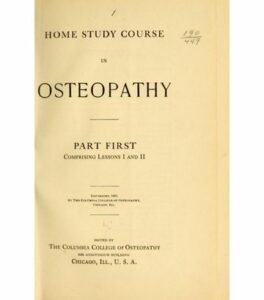1902 Home Study Course in Osteopathy by the Columbia College of Osteopathy
This volume is the textbook sold by an institution of osteopathy by correspondence, The Columbia College of Osteopathy, founded by Dr Barber after the National School of Osteopathy bankruptcy.
 Publisher: Columbia College of Osteopathy, Chicago, Illinois (USA)
Publisher: Columbia College of Osteopathy, Chicago, Illinois (USA)
Year of publication: 1902
Number of pages: 160
The volume is divided into several parts, each with an independent page numbering.
The first part (31 pages) contains the first two lessons on the theoretical and practical principles of osteopathy.
The second part (27 pages) is articulated into 3 lessons: the first lesson on gastrointestinal disorders, the second on the pathologies of liver, kidneys, pancreas, spleen, bladder, rectum and anus; the third on respiratory system disorders.
Also the third part (31 pages) contains three lessons: the first on rheumatism, low back pain and gout, the second on goiter, tumors, skin, articular, ocular and otolaryngological diseases; the third on nervous disorders.
In the fourth part (32 pages) there are two lessons: the first on febrile states and gynecological pathologies, the second on the skeleton, muscles, circulation and nervous system.
The fifth and last part (30 pages) contains the last two lessons, the first on: respiratory organs, digestive system, skin and genital organs.
The book ends with a miscellaneous work on the success of osteopathy and the necessary instructions to open a practice. In this last lesson there are two interventions by professional osteopaths, the first emphasizes the usefulness of mental therapy and the points of convergence between osteopathy and the movement of the New Thought, the second one expresses an opinion contrary to the antitoxins.
After reading these 12 lessons, contained in a book of 160 pages, the paying student would earn the title of D.O.. Between the end of the nineteenth century and the beginning of the twentieth century, especially in the states where osteopathy was not yet regulated, a proliferation of correspondence or simply not very serious osteopathic schools was observed. The Committee on Education of the AOA tried to limit the spread of such initiatives, although, it was possible to stop it completely only after the entry into force of the laws for recognition.1
Strengths: of merely historical interest.
Weaknesses: volume semplicistico e con una prospettiva molto diversa da quella del fondatore.
- Gevitz N. The DOs: Osteopathic Medicine in America. 2nd edition, Baltimore, MD: Johns Hopkins University Press; 2004.

Are you an osteopath?
Register and enjoy the membership benefits. Create your public profile and publish your studies. It's free!
Register now
School or training institution?
Register and enjoy the membership benefits. Create your public profile and publish your studies. It's free!
Register now
Do you want to become an osteopath? Are you a student?
Register and enjoy the membership benefits. Create your public profile and publish your studies. It's free!
Register nowHistorical osteopathy books
Osteopathy Research and Practice by Andrew Taylor Still
The fourth book of A.T. Still, written at the age of 82 years, enunciates the principles and the practical maneuvers of osteopathy in reference to the single pathologies, classified by body regions.
ReadHistory of Osteopathy and Twentieth-Century Medical Practice by Emmons Rutledge Booth
A milestone in the history of osteopathy. Emmons Rutledge Booth, who enrolled at the ASO in Kirksville in 1898 and graduated in 1900, met A.T. Still personally.
ReadPhilosophy of Osteopathy by Andrew Taylor Still
The second book published by A.T. Still, it collects the basic principles of osteopathy, written over several years and then gathered in one volume. Despite the insistence of his friends, Still was not sure that the time was ripe to divulge his early science.
ReadAutobiography of Andrew Taylor Still with a History of the Discovery and Development of the Science of Osteopathy by A. T. Still
A fundamental text to begin to know the founder of osteopathy and to understand the cultural context and the historical events during which his life unfolded.
ReadPrimitive Physick: or, an Easy and Natural Method of Curing most Diseases by John Wesley
A fundamental text for the Methodists, which Still’s father surely knew and probably owned - in addition to remedies, the book contains a preface that dispenses advice for a healthy life.
ReadThe Old Doctor by Leon Elwin Page
A small volume dedicated to the story of Andrew Taylor Still, and to the birth and development of the idea of osteopathy.
ReadThe Cure of Disease by Osteopathy, Hydropathy and Hygiene A Book for the People by Ferdinand L. Matthay
A small volume addressed to the general public, dispensing health advice and illustrating some osteopathic techniques.
ReadOsteopathy; the New Science by William Livingston Harlan
The volume collects and comments a series of relevant articles on the new science of osteopathy, highlighting legal, historical and theoretical aspects.
ReadA Manual of Osteopathy – with the Application of Physical Culture, Baths and Diet by Eduard W Goetz
Very schematic volume, with the aim of spreading the osteopathic application techniques to everybody, even to those lacking any sort of health training.
Read







